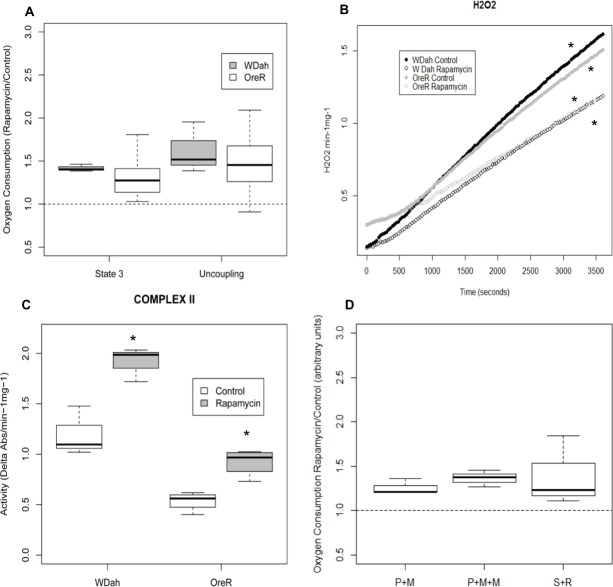Fig. 1.
Effects of rapamycin on mitochondrial functions. (A) Oxygen consumption during state 3 (ADP added) and after addition of FCCP uncoupler (uncoupling) in two D. melanogaster laboratory strains (wDah and OreR) fed with rapamycin for 10 days. Results are shown as the ratio of rapamycin (Rapa) to vehicle control treatment. Ratios were assessed for significance by a Wilcoxon signed rank test. State-3, V = 0, P = 0.00; uncoupling, V = 1, P = 0.00. V, sum of ranks in which the ratio rapamycin:control is below 1. (B) H2O2 production of mitochondria isolated from wDah and OreR flies treated with rapamycin or vehicle control for 10 days. *P<0.05 versus control as determined by ANCOVA: wDah, treatment: F value, 835.9, P<0.00; OreR, treatment: F value, 161.3, P<0.00. (C) Enzymatic activity of complex II in isolated mitochondria from wDah and OreR flies treated with rapamycin or vehicle control for 10 days. Enzymatic activity was normalized to sample protein content. *P<0.05 versus control as determined by Student's t-test. wDah, P = 0.004; OreR, P = 0.003. (D) Effects of rapamycin on complex-I- and complex-II-mediated respiration. Oxygen consumption during state 3 (ADP added) of complex I (pyruvate and malate, or pyruvate, malate and malonate), complex II (succinate and rotenone) of mitochondria from flies fed with rapamycin for 10 days. Results are shown as the ratio of rapamycin to vehicle control. Ratios were assessed for significance by a Wilcoxon signed rank test (V = 0, P = 0.004). The whiskers represent the 10th–90th percentile; the box represents the 25th–75th percentile; the middle line is the median. Abs, absorbance.

